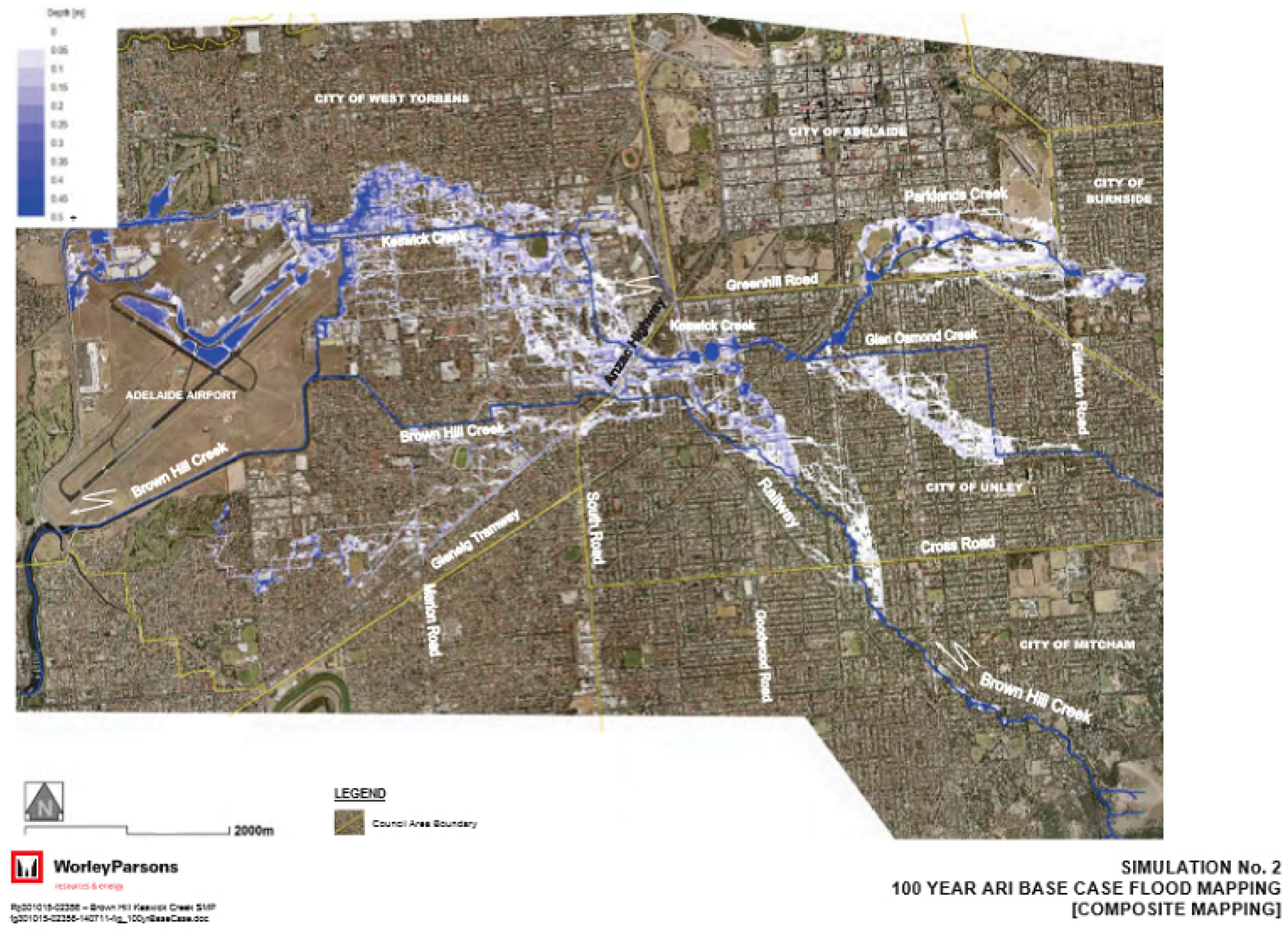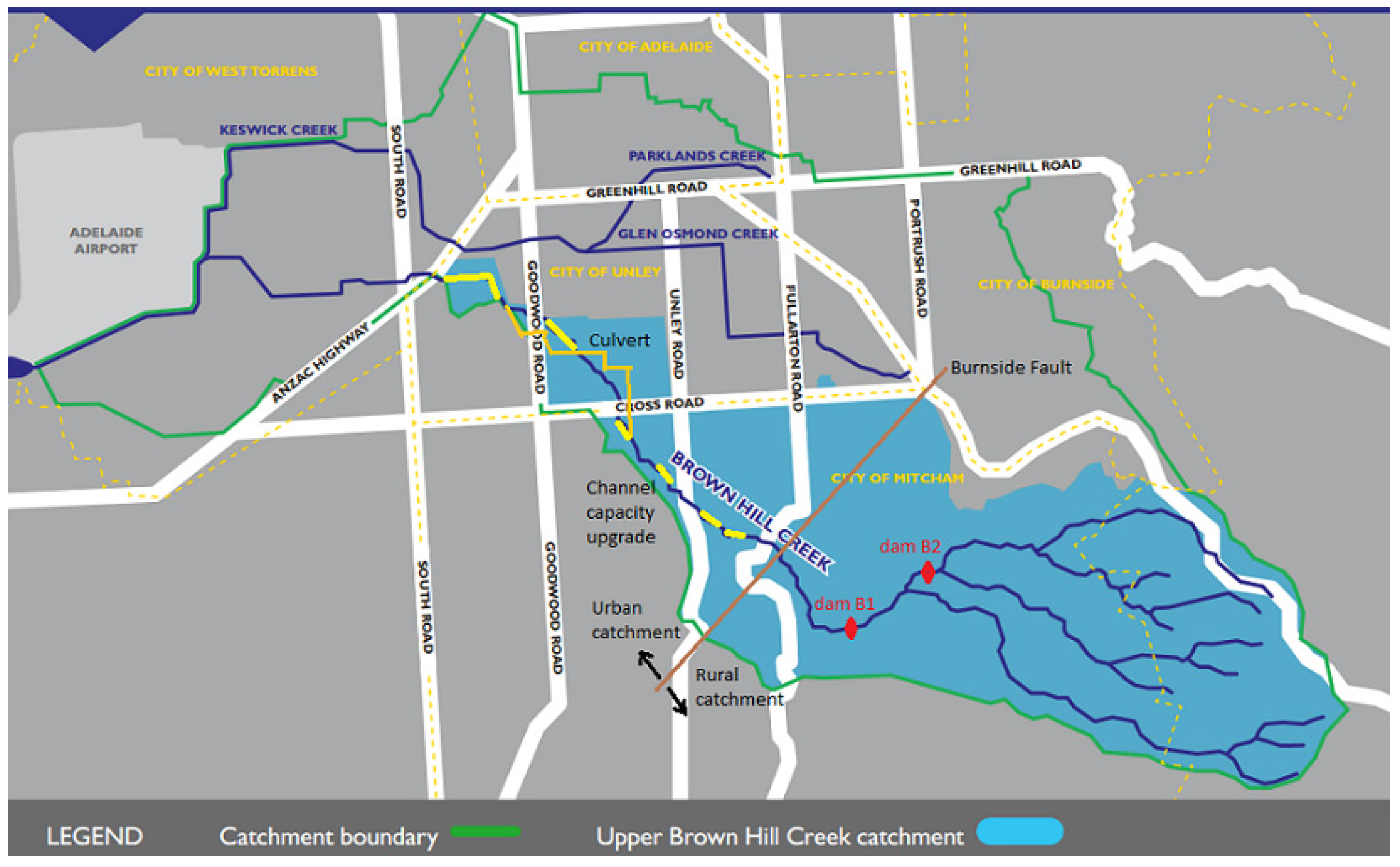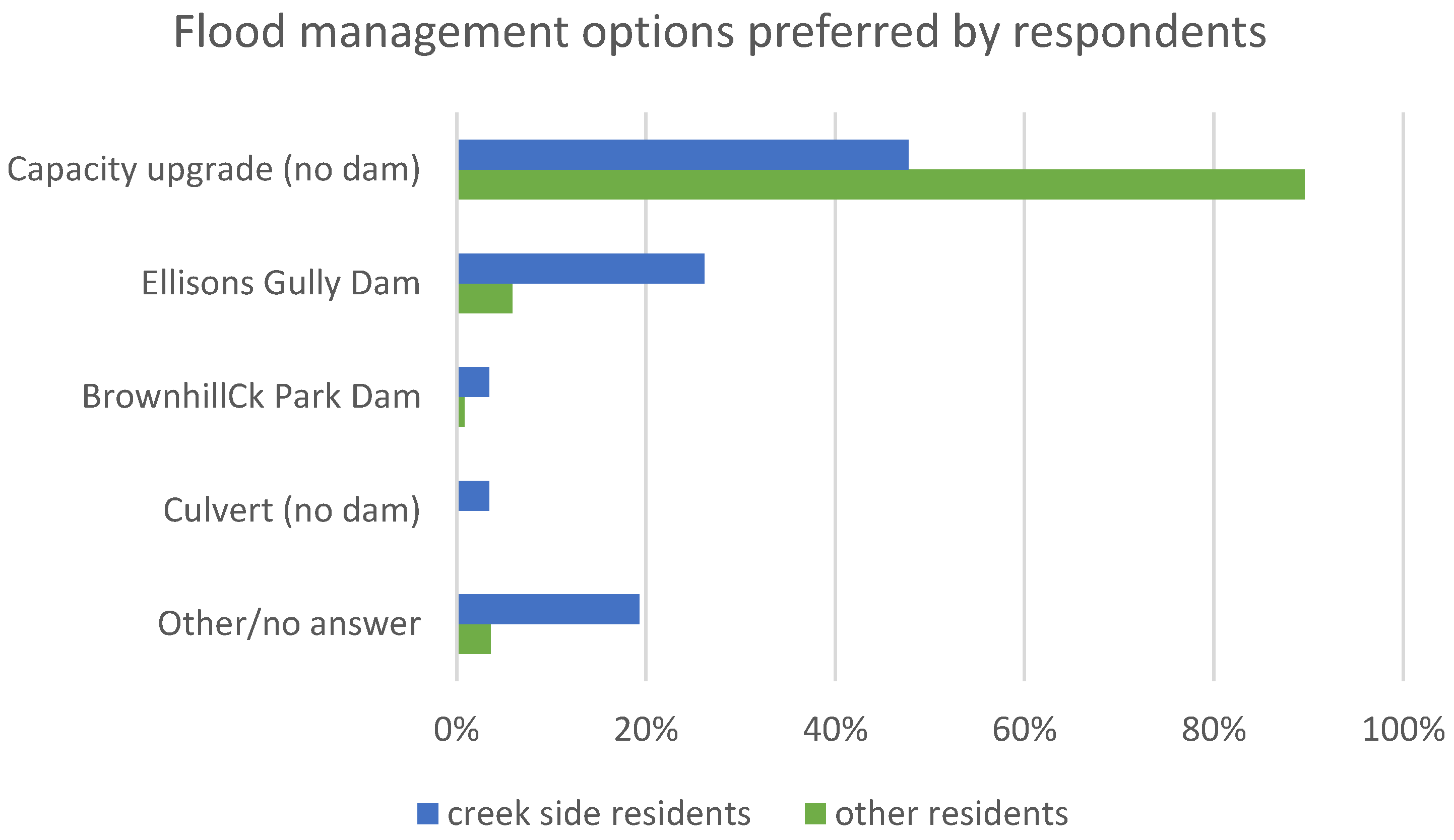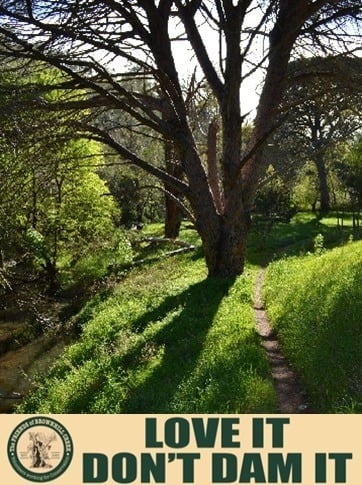Community Perspective on Consultation on Urban Stormwater Management: Lessons from Brownhill Creek, South Australia
Abstract
:1. Introduction
2. Institutional and Geographical Setting
2.1. Responsibilities and Interactions between Levels of Government
2.2. Brownhill Creek Geography and Flood Risk
3. Brownhill Creek Consultation Case Study—Materials and Methods
3.1. First Consultation—Hydrological Aspects
3.2. First Consultation—Human Dimensions
3.3. Second Consultation—Hydrological Aspects
- use recently revised Bureau of Meteorology flood frequency-duration-intensity curves,
- re-survey the creek channel hydraulic capacity and status,
- evaluate culvert options to allow bypass flows in constricted sections,
- estimate the size and cost of expanding channel capacity (including land acquisition and easement costs) and also in making good overgrown sections of channel,
- consider locating the dam further upstream in a tributary, Ellisons Gully,
- remodel flood hydrographs and damage estimates for the three design storms for all Upper Creek intervention options assuming that the Lower Creek interventions were in place, and
- present the results to the constituent Councils and catchment community in a report and undertake a public consultation survey on a revised plan in Upper Brownhill Creek.
3.4. Second Consultation—Human Dimensions
- updated its web site, Facebook and Twitter sites with the new information;
- letterboxed two council areas encouraging community members to respond;
- manned a booth at a shopping centre to spread the message and extend the petition;
- sent letters to the editors of local newspapers and were represented on radio and television;
- placed advertisements in local newspapers and sent out press releases;
- gained further statements of support from relevant credentialed aboriginal heritage and environmental conservation organisations;
- arranged expert evaluation of stone pines at the primary dam site which revealed they were Australia’s largest specimens and were subsequently recorded on a national register of trees of significance;
- publicly displayed numerous banners and signs;
- made deputations to councils involved and lobbied for support;
- addressed community groups and visitors to the Brownhill Creek Recreation Park;
- conducted a heritage walk along the upper creek through Ellisons Gully;
- produced and circulated a children’s book about yabbies in the creek; and
- produced two YouTube videos on children playing in Brownhill Creek.
4. Results
4.1. Outcome of First Community Consultation
4.2. Outcome of Second Community Consultation
5. Discussion
5.1. State and Local Government Interaction
5.2. Interactions among Councils
- a dam in either the Brownhill Creek Recreation Park or on a tributary in Ellisons Gully further upstream;
- diversion culverts and pipes around constricted sections of creek; or
- widening of the creek channel (upgrading capacity) at critical sections.
5.3. Local Action Groups
- No dams action group of Brownhill Creek Association (BCA)—to oppose dams at both prospective sites, aimed at improving environmental and community outcomes at least cost;
- Save Our Streets Community Action Group (SOSCAG)—to protect street trees whose health and survival could be threatened by construction of major culverts under streets in Unley and Mitcham;
- Save our Creek Environs Trees (SOCKET)—to protect rights and autonomy of creek-side land owners or maximize compensation if easements are imposed.
6. Corollary
7. Conclusions
- Engage with the community early while draft plans and options are flexible and expandable, well before reaching a formal public consultation phase.
- Do your homework and ensure that data, which could change priorities of options, is correct before engaging in modelling work. Do sensitivity analyses on all assumptions that have potential to change the preferred option.
- Consider the full range of costs and benefits for each option and quantify or at least rank the impact of options on environmental and social externalities.
- Put all options on the table. Do not omit obvious solutions because of fear that they will be unpalatable with influential parties.
- Where options depart from existing soundly based policies and strategies that have developed with effective consultation, there should be a clear rationale for the departure and the consequences for the achievement of the objectives of those policies.
- Ensure those that may be affected have a clear understanding of how and how much they may be affected, and how this may be mitigated.
- Do not dismiss people’s opinions because they have a different perspective from those of the project proponents or consultants. There are many dimensions to problems and solutions and a consultant cannot be expected to know them all, but can reasonably be expected to listen and broaden their perspective, and improve investigations and recommendations.
- The costs to a community to campaign for the ultimately most popular solution in this case amounted to more than $200,000 in in-kind labor as well as more than $10,000 in communications costs. Much of this could have been avoided by improved engagement with the community at an early stage. The costs to the community are generally neglected in decision making and achieving a suitable standard of rigor in investigations, and consulting the community in framing investigations could save on gross expenditure and speed up approval processes.
Acknowledgments
Author Contributions
Conflicts of Interest
Abbreviations
| AMLRNRMB | Adelaide and Mount Lofty Ranges Natural Resources Management Board |
| BCA | Brownhill Creek Association |
| BHKCSP | Brown Hill Keswick Creek Stormwater Project |
| BOM | Bureau of Meteorology |
References
- Brown Hill Keswick Creek Stormwater Project. 2012. Available online: http://bhkcstormwater.com.au/ (accessed on 19 April 2016).
- Brown Hill Keswick Creek Stormwater Project. Brown Hill Keswick Creek Catchment Stormwater Management Plan 2016. 2016. Available online: http://bhkcstormwater.com.au/ (accessed on 19 April 2016).
- URPS in Association with Natalie Fuller and Associates Pty Ltd; Harlen Graphics. Brown Hill Keswick Creek Draft Stormwater Management Plan: Community Consultation Report; Prepared for the Brown Hill Keswick Creek Stormwater Project; 2012. http://bhkcstormwater.com.au/ (accessed on 19 April 2016).
- Brown Hill Keswick Creek Stormwater Project. 2014. Available online: http://bhkcstormwater.com.au/ (accessed on 19 April 2016).
- Dean, A.; Fielding, K.; Newton, F.; Ross, H. Community Engagement in the Water Sector: An Outcome-Focused Review of Different Engagement Approaches; Report Project A2.3; Cooperative Research Centre for Water Sensitive Cities: Clayton, Australia, 2016. [Google Scholar]
- Lacroix, K.M.; Megdal, S.B. Explore, Synthesize, and Repeat: Unraveling Complex Water Management Issues through the Stakeholder Engagement Wheel. Water 2016, 8. [Google Scholar] [CrossRef]
- IAP2 (The International Association for Public Participation). The IAP2 Public Participation Spectrum. 2015. Available online: http://www.iap2.org.au/resources/public-participation-spectrum (accessed on 19 April 2016).
- Brownhill Creek Association. 2015. Available online: www.brownhillcreek.org (accessed on 19 April 2016).
- Natalie Fuller; Associates Pty Ltd in Partnership with URPS. Consultation findings on the Brown Hill Keswick Creek Stormwater Project: Part B Report. Prepared for the Brown Hill Keswick Creek Stormwater Project. 2015. Available online: http://bhkcstormwater.com.au/ (accessed on 19 April 2016).
- South Australia; Natural Resources Management Council. State Natural Resources Management Plan 2012-17. Available online: http://www.environment.sa.gov.au/about-us/our-plans (accessed on 19 April 2016).
- South Australia; Adelaide and Mount Lofty Ranges Natural Resources Management Board. Creating a Sustainable Future: Adelaide and Mount Lofty Ranges Natural Resources Management Plan Volume 1 Strategic Plan 2014-15 to 2023-24. Available online: http://www.naturalresources.sa.gov.au/adelaidemtloftyranges/about-us/our-regions-plan (accessed on 19 April 2016).
- South Australia; Department of Planning and Local Government. The 30-Year Plan for Greater Adelaide. 2010. Available online: http://www.dpti.sa.gov.au/planning/30_year_plan (accessed on 19 April 2016). [Google Scholar]
- South Australia; Department for Water. Stormwater Strategy—The Future of Stormwater Management. 2011. Available online: http://www.environment.sa.gov.au/managing-natural-resources/water-use/water-resources/stormwater (accessed on 19 April 2016). [Google Scholar]
- South Australia; Environment Protection Authority. Adelaide Coastal Water Quality Improvement Plan. 2011. Available online: www.epa.sa.gov.au/files/477449_acwqip_final.pdf (accessed on 19 April 2016). [Google Scholar]
- Brownhill Creek Association. A stormwater plan that fails the planning criteria. 2012. Available online: http://brownhillck.org/submissions (accessed on 19 April 2016).
- Murray-Darling Basin Authority. Constraints Management Strategy 2013 to 2024. Commonwealth of Australia, 2013. Available online: http://www.mdba.gov.au/publications/mdba-reports/constraints-management-strategy (accessed on 19 April 2016). [Google Scholar]
- FloodSafe: Community FloodSafe Program in South Australia-Increasing Resilience in Urban Communities Facing Flood Risk. 2009. Available online: http://www.ses.sa.gov.au/site/community_safety/floodsafe.jsp (accessed on 19 April 2016).



| Inform | Consult | Involve | Collaborate | Empower |
|---|---|---|---|---|
| Consultation on Plan 2011 | Options specified by BHKC project and feedback sought from community. | |||
| Consultation on Plan 2015 | Options specified by BHKC project and feedback sought from community. | Action groups given opportunity to comment on consultation process. | ||
| Implementation of Plan | (not currently considered: Opportunities for participation in non-structural measures (e.g., flood preparedness programs), and measures to meet objectives other than flood mitigation.) | Channel capacity is specified by BHKC and designs to achieve this are developed and agreed with each riparian land holder, under either an easement or an agreement. | (not currently considered: However there are opportunities for household stormwater maangement options beyond council requirements.) |
| Connunity Sector | Number of Forms Issued | Number of Responses Received | Percentage Responding | Distribution Method and Follow-up |
|---|---|---|---|---|
| 1st Community Consultation, 31 October 2011–12 December 2011 | ||||
| Owners of properties potentially affected by floods, creek-side owners, state govt. representatives and others determined by BHKC Project Office (criteria not specified) by council area… | 26,539 | 2,278 | 8% | Direct mail to owner. Also community newspaper notice to advise that Feedback forms available from council web sites, from 3 open days in community centres. There was no differentiation in reporting by source of feedback form. |
| Mitcham | 1,055 | 535 | 52% | |
| Unley | 6,157 | 638 | 10% | |
| Burnside | 2,290 | 90 | 4% | |
| Adelaide | 176 | 73 | 42% | |
| West Torrens | 16,861 | 942 | 5% | |
| Others | 4010 | na | An unsolicited petition contained 4,010 signatures of residents opposed to a dam in Brownhill Creek was submitted by the No Dam in Brownhill Creek Action Group to the City of Mitcham and forwarded into the consultation process. | |
| 2nd Community Consultation, 13 May 2015–23 June 2015 | ||||
| Creek side property owners in Mitcham | 90 | 49 | 54% | Direct mail to owner and followed up by a letter and phonecall |
| Creek side property owners in Unley | 126 | 39 | 31% | Direct mail to owner and followed up by a letter and phonecall |
| All other residents | 1,074 | 730 | 68% | Community newspaper notice to advise that forms are available on request. No follow up. |
| Total | 1,290 | 818 | 63% | |
| Council Area | Number of Respondents | % Support No Dam | % Support Dam | % No Opinion |
|---|---|---|---|---|
| Mitcham | 535 | 74% | 22% | 4% |
| Unley | 638 | 30% | 61% | 9% |
| Burnside | 90 | 37% | 11% | 52% |
| Adelaide | 73 | 76% | 6% | 18% |
| West Torrens | 942 | 7% | 82% | 11% |
| Total | 2,278 | |||
| Weighted Mean | 100% | 33% | 57% | 10% |
| Unweighted Mean | 45% | 36% | 19% | |
| Unweighted Standard Deviation | 27% | 30% | 17% |
| Written Submissions | Number of Written Submissions | Supporting Option D (No Dam) | Opposing Option D (No Dam) | Support or Opposition Not Stated |
|---|---|---|---|---|
| Mitcham residents | 26 | 24 | 0 | 2 |
| Unley residents | 13 | 7 | 5 | 1 |
| Other residents | 21 | 21 | 0 | 0 |
| Interest groups | 13 | 6 | 7 | 0 |
| Businesses | 2 | 2 | 0 | 0 |
| Members of South Australian parliament | 1 | 1 | 0 | 0 |
| Total | 76 | 61 | 12 | 3 |
| % of submissions | 100% | 80% | 16% | 4% |
| Action Group | Geographic Spread | Primary Motivation | Other Motivations | Preferred Option |
|---|---|---|---|---|
| BCA | Dispersed widely but mostly in Mitcham where creek ecosystem values highest and nearest to recreation park where dam had been proposed | Environmental and heritage protection in recreation park and natural areas, Preserve recreational amenity | Improve creek environment in urban area, minimizing costs to the community, establish a green corridor, stream water quality improvement, enhanced stormwater harvesting. | D (selective channel widening with no dam) |
| SOSCAG | Predominantly residents of Unley streets where culverts had been considered an option | Protect street trees from culvert construction, avoid inconvenience of protracted major earthworks on residential streets | Preservation of existing trees in urban creek line, minimizing costs to the community. | Various including D (selective channel widening with no dam) and dam B2 (location in Ellisons Gully) |
| SOCKET | Minority of residents owning creek-side properties in Mitcham and Unley | Retain control of their own land, fear of loss of land value, inconvenience and risks of earth works adjacent family home. | Preservation of existing trees in urban creek line, maximizing compensation to affected streamside landholders. | B2 dam (location in Ellisons Gully) |
© 2016 by the authors; licensee MDPI, Basel, Switzerland. This article is an open access article distributed under the terms and conditions of the Creative Commons Attribution (CC-BY) license (http://creativecommons.org/licenses/by/4.0/).
Share and Cite
Dillon, P.; Bellchambers, R.; Meyer, W.; Ellis, R. Community Perspective on Consultation on Urban Stormwater Management: Lessons from Brownhill Creek, South Australia. Water 2016, 8, 170. https://doi.org/10.3390/w8050170
Dillon P, Bellchambers R, Meyer W, Ellis R. Community Perspective on Consultation on Urban Stormwater Management: Lessons from Brownhill Creek, South Australia. Water. 2016; 8(5):170. https://doi.org/10.3390/w8050170
Chicago/Turabian StyleDillon, Peter, Ron Bellchambers, Wayne Meyer, and Rod Ellis. 2016. "Community Perspective on Consultation on Urban Stormwater Management: Lessons from Brownhill Creek, South Australia" Water 8, no. 5: 170. https://doi.org/10.3390/w8050170







